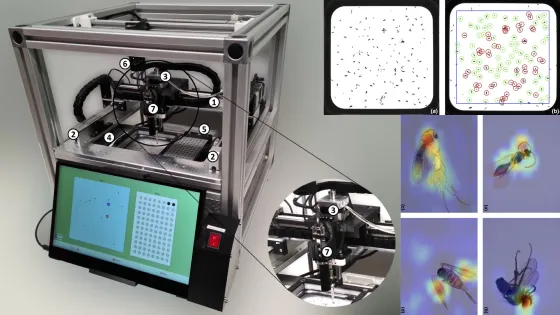Accelerating biodiversity discovery in hyperdiverse arthropod clades with robots and Nanopore sequencing
Rudolf Meier, from the Museum fur Naturkunde in Berlin, will discuss his novel methods to accelerate biodiversity discovery and monitoring of "dark taxa" using robotics, machine learning imaging and nanopore sequencing.
Speakers
Event series
Content navigation
Description

The biodiversity of arthropods remains poorly understood although this taxon comprises much of the terrestrial animal biomass, most species, and supplies many ecosystem services. One obstacle is specimen-rich samples obtained with quantitative sampling techniques (e.g., Malaise trapping). Traditional “morpho-species” sorting requires too much time.
At the Center of Integrative Biodiversity discovery at the Museum für Naturkunde in Berlin, we work on specimen-based approaches that pick individual specimen from bulk samples for barcoding. We developed a robot (“DiversityScanner”) that detects, images, and measures individual specimens and moves them into the wells of a 96-well microplate. The images are used to train convolutional neural networks (CNNs) that are currently capable of assigning the specimens to common 14 insect “families”. To obtain biomass information, the images are also used to measure specimen length and estimate body volume. In order to obtain DNA barcodes, we have developed robust and cost-effective barcoding techniques involving ONT sequencers and bioinformatics tools that allow for approximate species-level sorting.
About Rudolf
Prof. Rudolf Meier is the head of the Center for Integrative Biodiversity Discovery at the Museum für Naturkunde where he and his lab are at the forefront of novel methods to accelerate biodiversity discovery and monitoring using robotics, machine learning imaging and nanopore sequencing. The main foci of this work are the hyper-diverse invertebrate groups that are traditionally extremely difficult to sort, identify and describe – "dark taxa", groups for which <10% of all species are described and the estimated diversity exceeds 1000 species.
- Artificial intelligence could help biologists classify the world's tiny creatures
- ONTbarcoder and MinION barcodes aid biodiversity discovery and identification by everyone, for everyone
- DiversityScanner: Robotic handling of small invertebrates with machine learning methods
Location
Please note: this seminar will be held in the Slatyer Seminar Room and via Zoom, details are included below.
Slatyer Seminar Room, 2nd floor, RN Robertson Building, Research School of Biology, ANU
Please click the link below to join the webinar:
https://anu.zoom.us/j/87602600828?pwd=UzdRL3Y1bS9qdklYcFZsdGJhUFU5QT09
Passcode: 247618
Canberra time: please check your local time & date if you are watching from elsewhere.

